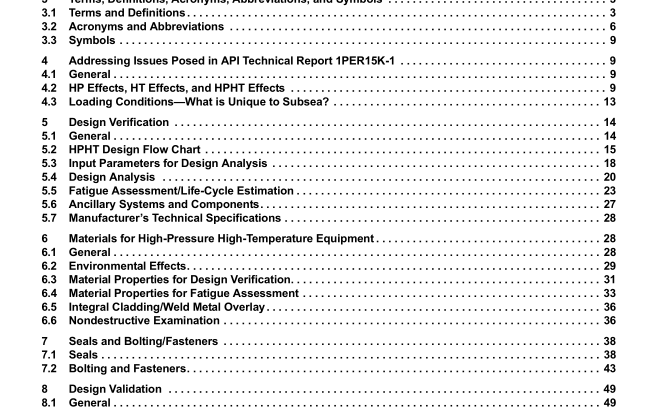API TR 17TR8:2015 pdf free download.High-pressure High-temperature Design Guidelines
4 Addressing Issues Posed in API Technical Report 1PER15K-1
4.1 General API Technical Report 1PER15K-1: Protocol for Verification and Validation of HPHT Equipment (API 1PER15K-1), takes a system level approach to the review of the entire well system, exposed to HPHT conditions. API 1PER15K-1 does not offer analysis tools or design processes for the verification or validation of specific hardware. For that reason, the intent of this technical report is to provide guidance on analysis tools and design processes to address the applications cited in API 1PER15K-1 for the design verification and validation of subsea production hardware and systems.
4.2 HP Effects, HT Effects, and HPHT Effects
4.2.1 HP Effects
4.2.1.1 General A broad range of pressure-containing oilfield equipment design is based on the definitions and formulae found in API 6A and API 6X. This is based on ASME Boiler and Pressure Vessel Code (BPVC) Section VIII, Division 2: 2004 Edition (hereafter ASME Div. 2: 2004). There are limited data available on the use of 30 ksi RWP equipment based on API 6AB (withdrawn) and on 20 ksi RWP equipment based on API 6A in production conditions above 15 ksi; both derived from ASME Div. 2: 2004 design methodology.
The design practice from ASME for equipment with design pressure greater than 10 ksi suggests that the equipment designer should consider ASME Section VIII, Division 3. This is the ASME recommendation, but not its requirement. It should be noted that ASME Div. 2 does not specify a limitation on the pressures for which it can be used. For very high pressures (e.g. 20 ksi, 25 ksi, 30 ksi), additional considerations to design and manufacturing practices should be applied to meet the design principles and manufacturing practices to subsea equipment with such pressure ratings. API documentation continued reference to ASME Div. 2: 2004 where this is not in conformance with ASME’s current edition. This was an underlying intent in the development of API 6X where referencing the ASME documents is minimized and API equipment designs will not be subject to unnecessary changes due to revision to the ASME documents.
4.2.1.2 Analytical Methods With reference to the current ASME BPVC Section VIII, Division 2: 2013 Edition (hereafter ASME Div. 2) and ASME BPVC Section VIII, Division 3: 2013 Edition (hereafter ASME Div. 3), it should be noted that the design practices and analytical methods (e.g. linear-elastic, elastic-plastic) are similar in principle between these two (2) codes, however, they have different design margins against the plastic collapse load (ASME Div. 2 = 2.4 and ASME Div. 3 = 1.8) and minimum hydrostatic body test pressures. Both design codes utilize the analytical methods referenced therein to verify that the pressure vessel has adequate protection against typical failure modes (i.e. global plastic collapse, local strain damage limits, etc.). Additionally, ASME Div. 3 implements the use of fracture mechanics (FM) analysis to address the potential fast- fracture failure of pressure vessels from material flaws and/or imperfections occurring randomly in critically stressed locations (i.e. structural discontinuities, notches, sharp corners, etc.). ASME Div. 2 references the traditional stress- cycles fatigue curves (S-N curves) to address fatigue/life-cycle estimation if the equipment is identified to be fatigue sensitive from the screening process.
4.2.1.3 Thin-Wall and Thick-Wall Designs The transition from 15 ksi to higher RWPs tends to change designs from thin-wall to thick-wall pressure vessel designs, where thick-wall is the result of the vessel inside radius to vessel wall thickness ratio equal to or less than “4” (R/t ≤ 4: ASME Div 2: 2007 and later) or an outside to inside diameter ratio equal to or greater than “1.25” (Do/Di ≥ 1.25: ASME Div 3: 2010 and later).
Two (2) fundamental changes are occurring when transitioning from thin-wall to thick-wall pressure vessel designs.
1) The internal bore yielding (pressure) effect, typically referred to as an “autofrettage” effect (see 3.1.1.).
2) The pressure vessel’s possible susceptibility to cyclic loads could theoretically lead to either a fatigue failure or a fast-fracture failure at areas of highly localized stress. This phenomenon is typically associated with stress concentrations on the inside at sharp corners, such as bore intersections, seal pockets or abrupt changes in bore diameters, as autofrettage is experienced.
Cyclic loading effects on stress concentrations has been a long standing practice for fatigue failure utilizing S-N curves for predicting when and/or where materials may fail from external mechanical loads. However, the potential fatigue failure can now occur inside as well as outside from imperfections or flaws at highly stressed locations from high pressure loads or mechanical cyclic loads. API TR 17TR8 pdf download.API TR 17TR8:2015 pdf free download
